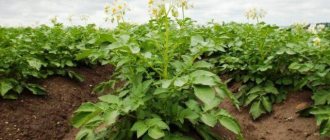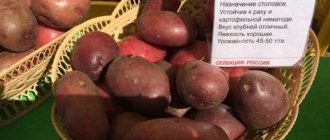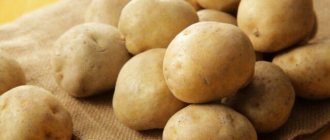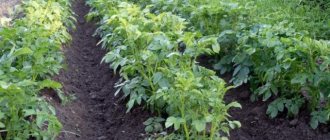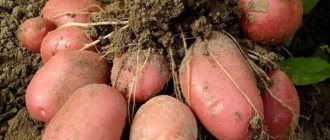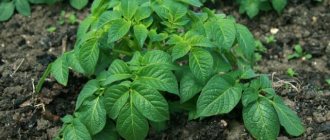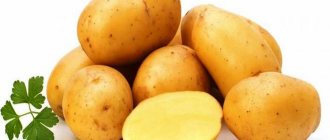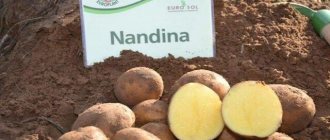The Krepysh potato appeared relatively recently, but many gardeners have already been able to appreciate it. After all, this variety is able to easily adapt to different climatic conditions and at the same time show stable yields. They also speak positively about the taste of this potato. However, for successful cultivation, you need to familiarize yourself with its strengths and weaknesses in advance, as well as study its characteristics.
Potatoes are suitable for mechanical harvesting
Description of seed potatoes of the Krepysh variety
The variety has some features in the appearance of bushes and tubers. Thanks to this, it stands out from other types of culture.
Bush
Potato Krepysh forms medium-sized or tall bushes of an intermediate type, 60-65 cm high. Its stems are erect at the initial stage of growth, and subsequently slightly bend to the sides. The leaves are medium in size, about 9-10 cm long. Their color is green, but sometimes becomes darker. There is moderate to strong waviness along the edge of the plates. Veins are not visible on the surface. The shoots are densely leafy at the top and bare at the bottom.
Flowering is long lasting. The corollas are large, up to 1 cm in diameter, red in color with a purple tint. The anthocyanin color on the inside is absent or barely noticeable. Inflorescences consist of 8-9 buds.
Important! The berry production of this variety is minimal.
The Krepysh potato blooms in the third ten days of June when planted in mid-May
Tubers
The root system of this type of crop is quite well developed. Under one bush, 7-13 tubers are formed, the average weight of which is 78-105 g. However, individual specimens can grow much larger. Krepysh's tubers are oval, uniformly yellow in color. The peel is smooth and transparent. When cut, you can see the cream-colored flesh with a dense consistency. The ocelli lie at an average depth or may be superficial.
The pulp of Krepysha tubers does not darken when in contact with air
Description, origin and development
Potato Krepysh is a Russian table variety of early ripening. They started growing it relatively recently. Krepysh was bred as a result of breeding work in 2000. This event took place at the All-Russian Research Institute of Potato Farming named after A.G. Lorha."
To obtain the variety, breeders used the numbered hybrid 2953-34 and potatoes of the Shurminsky-2 variety. Krepysh was included in the State Register of Plants of the Russian Federation in 2005.
Appearance of Krepysha tubers
Ripening time and yield
Krepysh is classified as an early ripening potato variety. After planting, the tubers need from 60 to 80 days to fully ripen (depending on the climatic conditions of the region). The first harvest can be harvested after 45 days.
Note! If all agrotechnical requirements are followed during the growing process, then from one bush you can collect from 15 to 20 tubers.
Disease resistance
Today, the Krepysh potato is very popular, the description of which indicates that the variety is resistant to scab, potato cancer, and golden cyst nematode.
Characteristics of tubers, description of appearance
Potato tubers Krepysh are oval and oblong in shape. They weigh on average from 80 to 105 grams. The skin on them is smooth and thin, yellow in color. Eyes are very rare.
The bushes are medium-sized, erect, growing up to 60 cm in height. They produce medium-sized green or dark green leaves with slightly wavy edges.
For reference! Flowering lasts for two weeks. At this time, bright purple flowers with a red tint appear on the bushes.
For which regions is it suitable, climate requirements?
Since the potato variety is unpretentious, it can be grown in all regions of Russia. The strong plant is also unpretentious to the climate and soil composition, which makes it very popular and in demand.
Seed potatoes Krepysh
Taste qualities
The Krepysh potato variety has excellent taste. The pulp of the tubers is cream-colored and has a delicate taste. Wateriness is completely absent. After cooking, the potatoes do not turn black and retain their shape well.
Characteristics of Krepysh potatoes
Only by studying the characteristics of potatoes of this variety can you get an idea of its productivity. This information will also allow you to find out its resistance to diseases.
Taste qualities of Krepysh potatoes
Judging by the reviews, Krepysh potatoes have a high taste, which has contributed to the growth of its popularity. During the cooking process, the pulp retains its consistency and does not become watery; it softens slightly. The starch content in tubers is 10-12.1%.
The fortress can be used for:
- first courses;
- salads;
- vegetable mixtures;
- boiling in its purified form and “uniform”;
- frying
This variety is also recommended for making French fries, chips and semi-finished products that require freezing.
Important! Potato Krepysh is distinguished by the friendly germination of shoots on the 25th day from the moment of planting in the presence of favorable conditions.
Ripening time for Krepysh potatoes
This variety belongs to the early ripening category. The duration of the growing season from the moment the sprouts appear is a little more than two months. However, when growing strong bushes to get an early harvest, you can dig up the bushes on the 45th day.
Productivity
Tests have shown that the yield of Krepysha exceeds the Zhukovsky early variety by 84 c/ha and amounts to 127-242 c/ha, depending on the timing of fruit harvest. At the same time, the yield of marketable tubers is about 86-99%. This indicator directly depends on weather conditions during the season and the correctness of fertilizing.
Growing regions
The Krepysh variety is recommended for cultivation in five regions of the country: Central, Northern, Central Black Earth, Northwestern, Far Eastern. But since Krepysh is characterized by rapid adaptation to different climatic conditions, it is suitable for cultivation throughout Russia, which is confirmed by reviews of experienced gardeners.
Disease resistance
According to the characteristics and description of the variety, the Krepysh potato is invulnerable to cancer, golden cyst nematode, scab, and viral infections. However, this species is susceptible to late blight. Therefore, it is necessary to carry out preventive treatments of bushes in case of prolonged rainy weather.
Diseases and pests
This variety of potato sometimes suffers from late blight.
This disease begins to appear immediately after the first shoots appear and is expressed in the appearance of dark spots on the leaves, and later on potato tubers.
To prevent the occurrence of this disease, it is necessary to apply spraying with contact fungicides at the beginning of tuber formation. All tops that remain after autumn harvesting must be burned immediately.
Solanaceae often develop diseases such as Alternaria, Verticillium wilt and Fusarium wilt; you can learn more about them in the materials on the site.
The main advantages of the Krepysh potato are its resistance to diseases, good taste and optimal level of starch content , as well as excellent keeping quality and high commercial quality.
As for pest attacks, the main damage to potatoes is caused by the Colorado potato beetle. Read all about folk remedies and chemicals for insect control in our articles.
We bring to your attention a table with keeping quality indicators for other potato varieties:
| Variety name | Keeping quality |
| Sifra | 94% |
| Queen Anne | 92% |
| League | 93% |
| Milena | 95% |
| Elmundo | 97% |
| Serpanok | 94% |
| Cast iron | 95% |
| Sheri | 91% |
| Bryansk delicacy | 94% |
| Ariel | 94% |
Advantages and disadvantages
The Krepysh potato has a lot of advantages, which explains its popularity among gardeners. But there are also certain disadvantages that need to be taken into account.
The keeping quality level of the Krepysh crop is 97%
Main advantages:
- stable yield;
- excellent taste properties;
- undemanding to the composition of the soil;
- quick adaptation to any climatic conditions;
- precocity;
- possibility of early collection;
- versatility of use;
- tolerates long-term storage and transportation;
- high yield of marketable tubers;
- does not suffer from drought;
- Suitable for mechanical collection.
Flaws:
- has no immunity to late blight;
- needs frequent hilling;
- susceptible to the Colorado potato beetle;
- demanding of fertilizing.
Advantages of fertilizer Krepysh
Based on numerous reviews from gardeners, we can conclude that the drug Krepysh has a large number of positive qualities.
Water-soluble organomineral fertilizer with potassium humate FASKO “Krepysh”
- The product is universal - suitable for many types of plants. There are species for seedlings and adult crops.
- The fertilizer is economical because it is highly concentrated. At the same time, the product contains many elements; with one fertilizing, the crop receives a whole complex of substances at once and additional fertilizers are not required.
- Plants quickly respond to the application of Krepysh fertilizer.
- The drug dissolves easily in water and is sold in packages with different quantities.
- It is convenient to store the drug.
Landing rules
Potatoes Strong need to be planted in early May. But if weather conditions are not conducive to this, then it is necessary to postpone the procedure for 1-2 weeks, since the tubers will not be able to fully develop in cold soil.
Experts recommend pre-germinating planting material. To do this, the tubers need to be brought into a room with a temperature of +15 C 20 days before planting and spread out in one layer. The potatoes need to be turned periodically to ensure even sprouting.
Due to the short growing season, for the full development of Krepysh bushes, soil rich in organic matter is required. Site preparation should begin in the fall. During this period, it is recommended to dig up the bed and add humus or fresh manure at the rate of 10 kg per 1 sq. m. m. With the arrival of spring, it is recommended to repeat loosening the soil, which will improve its aeration.
Important! For Krepysh you need to choose sunny open areas, well lit throughout the day.
You can plant Krepysh potatoes when the soil warms up to +8 °C
The best option for this variety is loam and sandy loam soil with good moisture and air permeability. It is also possible to plant Krepysh potatoes in heavy soil if you first add not only organic matter, but also sand at the rate of 10 kg per 1 sq. m. m.
The optimal depth for planting tubers is 10 cm. It is recommended to make holes at a distance of 35 cm, and maintain 65 cm between rows.
When growing Krepysh potatoes, crop rotation must be observed. The best precursors for the crop can be carrots, legumes, cabbage, and meadow grasses.
Agricultural technology for growing the variety
There are no particular differences in the agricultural technology for growing elite Lux potatoes. It is grown in open sunny areas rich in organic matter.
Potatoes can be planted in various ways:
- Under the shovel. This planting method is effective on flat areas. The most traditional method of planting, in which first shallow holes are dug at a distance of 30 to 35 cm to a depth of 6 to 8 cm, and sprouted potato tubers are placed in them. For better yield, add two or three handfuls of rotted manure or compost and a little wood ash to the bottom of the holes. The tubers are covered with soil, retreated 70-80 cm and the next row begins to be planted;
- In prepared combs. If the garden plot is located on heavy soils saturated with water, then it is recommended to plant potatoes in prepared earthen ridges, 15 to 20 cm high. To form the ridges, it is best to use a walk-behind tractor. Tubers are planted in holes, which are located at the top of the ridge 30 cm from each other. After planting the potatoes, mulch with mown grass or straw;
- In the trenches. This method is recommended for sandy soil types. In the fall, after digging up the garden, trenches with a depth of 30 to 35 cm are prepared with a distance of 80-90 cm between them. Raw hay is placed on the bottom layer to a thickness of 15 cm, and fresh manure mixed with wood ash is scattered on top. In winter, all components overheat and become denser. In early spring, when the snow has just melted, potato tubers are placed in trenches and covered with special agrofibre, such as agrospan;
- Into the straw. This ancient method has been used by farmers for 100 years. In autumn, the garden plot is generously covered with hay or straw. When planting in spring, potatoes are placed directly on rotted straw and re-covered with a layer of hay or straw. The tubers are placed in rows at a distance of 70-80 cm. When growing potatoes using this method, there is no need to weed or feed them. The harvest is easy to harvest, the tubers are clean and intact.
The planting method is chosen depending on the composition of the soil, the size of the plot and the desire of gardeners to experiment.
How to care
This variety is characterized by increased resistance to drought. Therefore, Krepysh potatoes need to be watered only in case of prolonged drought. Moistening should be carried out in the evening, soaking the soil to a depth of 10 cm.
Ten days after planting, it is recommended to carry out the first loosening of the soil to a depth of 2 cm. This is necessary to maintain air access to the tubers. In the future, it is necessary to do weeding several times as the weeds grow.
When the shoots reach a height of 10 cm, you need to carry out the first hilling of the bushes. In the future, the procedure should be done at the stage of stem height of 25 cm. It is also recommended for Krepysh to do the third hilling during the period of closure of the bushes. This significantly increases the yield of the variety.
Important! The variety is resistant to degeneration, but the seed material must be periodically renewed.
The robust potato responds well to fertilizing; it must be carried out taking into account the development of the potato. During the period of active growth of shoots and leaves, it is recommended to use ammonium nitrate at the rate of 30 g per 10 liters of water. At the stage of formation of flower stalks, you need to use nitroammophoska in the same proportion, and after flowering, superphosphate 30 g and potassium sulfide 25 g per bucket of water.
Growing rules
Since the seed material does not degenerate, you can use last year’s harvest for planting. It is best to choose medium-sized tubers. Before planting, they should be treated with growth-accelerating drugs and germinate in a cool room. It is recommended to plant the fortress in the ground in early May. To increase productivity, proper distribution should be followed. It should be remembered that a distance of 40 cm should be maintained between the rows. But between the bushes it is necessary to maintain a distance of 70 cm.
You should choose areas of soil that receive a large amount of sunlight. This will allow the soil to warm up faster after spring, and water will not stagnate in the ground. If you decide to plant Krepysh, then the seeds should be buried to a depth of 10 cm. After 14 days, you should loosen the soil and remove all existing weeds.
Before you start hilling or loosening the areas between the rows, you should feed the plant and soil. For this, it is recommended to use cow or bird droppings. Mineral fertilizers will also be ideal helpers. This variety is not picky about watering. But, it is recommended to water the plant intensively at the moment when flowers begin to form. To achieve high yields, organic and mineral fertilizers that do not contain high amounts of nitrogen should be added to the soil. It is better to use copper-containing preparations.
Harvest and storage
At the end of July, at the beginning of June, the Krepysha bushes begin to fade. When the shoots are completely dry, harvesting can be done. It is recommended to dig up potatoes in dry weather, and then leave the crop in the garden for two hours and only then move it indoors. It is recommended to dry the tubers for three weeks, which guarantees their long-term preservation in the future. And then the harvest can be transferred to the basement. Optimal storage conditions: temperature +4 °C and humidity 85%.
The Krepysh variety lasts well until the new harvest.
Ramona potatoes: planting and further cultivation
Some nuances will be discussed below. First of all, you need to remember that planting material degenerates after about 4 seasons, so care should be taken in advance to renew varietal tubers.
Planting potatoes Method of planting potatoes to obtain a high yield From A to Z - video
Important! Root tubers are sorted out, removing damaged, lethargic or with traces of disease. Good planting material is placed in a sunny place, where they must be kept for at least 10 hours every day.
In this case, the air humidity should be at least 85%.
Landing dates! In the southern regions, Ramona potatoes can be planted in March, and in regions with colder climates, the planting dates are shifted to the second half of May. You can also focus on the air temperature - during the day it should be at least +15 degrees Celsius, and at night - at least +5 degrees Celsius.
GOOD POTATO VARIETIES! Spring Potatoes Colombo Potatoes Rocco Potatoes
The best predecessors for potatoes are legumes, early varieties of cabbage, cucumbers and green manure.
The acidity of this soil should be neutral
dolomite flour And immediately before planting, during spring digging, mineral fertilizers are added to the soil: 2 tbsp. l. superphosphate, 1 tbsp. l. potassium sulfate and 1 cup of wood ash. These dosages are indicated for one square area of the site. Landing rules! The planting pattern for Ramona tubers is 0.4 m between adjacent holes. The row spacing should be 0.65 m. In heavy soil, planting material is buried to a depth of 7-8 cm, in sandy and sandy loam soils - to 9-10 cm.
Origin of white carrots
It is believed that the birthplace of the plant is Afghanistan. Other sources also name Iran and northern India (present-day Pakistan). The ancestor of all varieties of this vegetable is wild carrots. It has been cultivated as an economic crop for about 4,000 years. Surprisingly, at first it was grown for its fragrant tops and seeds. The annals of history mention the food use of root vegetables only from the 1st century AD. e.
But only in the 14th-15th centuries did white carrots, along with orange and red varieties, penetrate into Europe. Germany, England, France, and the Netherlands became interested in culture. Because the root vegetables had a bitter taste, they were grown as livestock feed.
It was only in the 17th century that the Dutch developed a sugar variety suitable for culinary use. And modern varieties of white carrots were obtained quite recently, in the 20th century. They were bred from yellow plant species that grew in the Middle East and South Asia.

